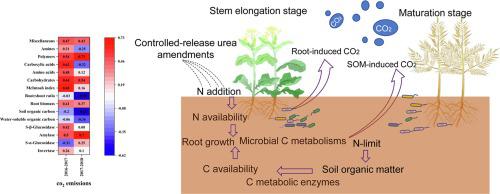Catena ( IF 5.4 ) Pub Date : 2020-06-15 , DOI: 10.1016/j.catena.2020.104747 Kangping Zhang , Meichun Duan , Qiwen Xu , ·Zhiyuan Wang , ·Bangyan Liu , ·Longchang Wang

|
Carbon (C) losses induced by soil amendments have been shown to trigger soil conservation concerns. However, the mechanisms of fertilizer-induced CO2 emissions are still unclear. Here, we investigated the impact of soil nitrogen (N) amendments at an upland site on soil C stocks, CO2 emission, microbial functional diversity, and soil enzymatic activities during the stem elongation and harvest stages of rapeseed in 2016–2018. Five treatments were designed including non-N fertilizer (N0), conventional urea (U), monotypic CRU fertilization (CRU), co-application of U with CRU (CRC), and CRU plus organic fertilizer (CRO). The key finding is that the significant increases in CO2 emissions from CRO soils were ephemeral compared with the N0 treatment. Root biomass and root: shoot ratio partly explained the significant effect of N addition to CO2 production. Further, improved amylase activities and increasing consumptions of carboxylic acids, polymers and miscellaneous by soil microbes were mainly responsible for enhanced soil CO2 emissions in both growing seasons (P < 0.01). This suggests that fertilizer-induced CO2 emission could be regulated by soil C and N availability, which is attributed to the dynamic changes in soil carbon metabolism. During the stem elongation of 2016–2017, the consumption of carbohydrates, carboxylic acids, polymers, amines, and miscellaneous in CRO treatment during the first sampling phase was 21.65%, 41.36%, 17.98%, 27.61% and 49.52% higher than those in traditional urea fertilizer, respectively. Moreover, compared to the CRU, U, and N0 treatments, the CRO treatment significantly increased the McIntosh index during the stem elongation of both seasons. The results indicate that a sensitive and rapid indicator to finding a good soil N management is short-term alterations in the microbial functional diversity. Additionally, a broad spectrum of the utilization of substrates by soil bacteria was showed in CRO plots, irrespective of interannual variations of precipitation from 2016 to 2018. In contrast, non-N and conventional urea treatments produced a greater disparity in the utilization of carbon substrates from across all sampling times compared with CRU amended treatments, and both of them were less correlated with the most C-sources. Overall, single basal CRO fertilization, as a stable N source, can satisfy plant and soil microbial C and N demands, hence mitigating soil CO2 emission.
中文翻译:

土壤微生物功能多样性和根系生长对土壤改良剂的响应导致雨养农田中CO 2排放
已经表明,土壤改良剂引起的碳(C)损失会引发土壤保护问题。然而,由肥料引起的CO 2排放的机制仍不清楚。在这里,我们调查了2016-2018年油菜茎伸长和收获阶段高地土壤改良氮对土壤碳储量,CO 2排放,微生物功能多样性和土壤酶活性的影响。设计了五种处理方法,包括非氮肥(N0),常规尿素(U),单型CRU施肥(CRU),U与CRU共同施用(CRC)以及CRU加有机肥(CRO)。关键发现是CO 2的显着增加与N0处理相比,CRO土壤的排放是短暂的。根的生物量和根:茎的比率部分解释了氮的添加对CO 2产生的显著作用。此外,改善的淀粉酶活性以及土壤微生物对羧酸,聚合物和其他物质的消耗增加是造成两个生长季节土壤CO 2排放增加的主要原因(P < 0.01)。这表明肥料引起的CO 2碳和氮的有效性可调节土壤的碳排放,这归因于土壤碳代谢的动态变化。在2016-2017年的茎伸长期间,在第一个采样阶段,CRO处理中碳水化合物,羧酸,聚合物,胺和杂物的消费量分别比分别高21.65%,41.36%,17.98%,27.61%和49.52%。传统尿素肥料分别。而且,与CRU,U和N0处理相比,CRO处理在两个季节的茎伸长期间均显着提高了McIntosh指数。结果表明,寻找良好土壤氮素管理的敏感而快速的指标是微生物功能多样性的短期改变。此外,在CRO图中显示了土壤细菌对底物的广泛利用,不管2016年至2018年的降水量年际变化如何。相比之下,非氮和常规尿素处理与CRU修正处理相比,在所有采样时间内产生的碳底物利用率差异更大,并且两者之间的相关性较小。最多的C源。总体而言,单一基础CRO施肥作为稳定的N源,可以满足植物和土壤微生物对C和N的需求,从而减轻了土壤CO2发射。











































 京公网安备 11010802027423号
京公网安备 11010802027423号